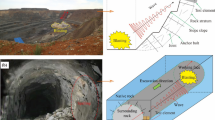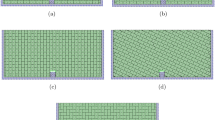Summary
Propellant embedded anchors can be used to secure offshore platforms by rapidly anchoring them in seafloor rock. Field tests conducted by the U.S. Navy showed inconsistent results. A more promising approach seems to be modelling of anchor penetration and pullout resistance in jointed rock based on first principles.
In this paper, physical model tests are described with which the physical phenomena are investigated and which will serve as a basis for predictive analytical models. The laboratory experiments, conducted with fasteners to model the anchors and with jointed and intact rock models made from gypsum, showed that basic intact material properties, joint configuration and individual joint properties influence penetration and pullout resistance. If the behavior is brittle, penetration is accompanied by cracking, otherwise ductile continuum deformation occurs. Jointing affects cracking in that closer joint spacing restricts cracking to fewer “joint bounded plates” but increases the number of cracks in the individual plate. The increased cracking intensity leads to a reduced pullout resistance.
For purposes of analytical modelling, one can therefore, in a first step, build upon established relations between intact meterial, joint geometry and individual joint characteristics.
Similar content being viewed by others
References
Baecher, G. B., Einstein, H. H. (1981): Size effect in rock testing. Geophys. Res. Lett. 18 7.
Bandis, G., Lumsden, A., Barton, N. (1981): Experimental studies of scale effects on the shear behavior of rock joints. Int. J. Rock Mech. Mining Sci. 18 6.
Barton, N., Lien, N., Lunde, J. (1974): Engineering classification of rock masses for the design of tunnel supports. Rock Mechanics 6/4.
Beard, R. M. (1984): Testing of a conical rock fluke for the 20k propellant embedded anchor; status report. Technical Memorandum 42-84-01, Naval Civil Engineering Laboratory, Port Hueneme, CA, U. S. A.
Colp, J. L. (1968): Teradynamics: A study of projectile penetration of natural earth materials. Sandia Laboratory, Albuquerque, Sc-DR-68-215. 61 p.
Einstein, H. H., Baecher, G. B., Hirschfeld, R. C. (1970): The effect of size or the strength of a brittle rock. Proc. 2nd Int. Congress on Rock Mechanics.
Einstein, H. H., Hirschfeld, R. C. (1973): Model studies on mechanics of jointed rock. J. ASCE Soil Mech. Found. Div. 99/SM3.
Einstein, H. H., Baecher, G. B., Beneziano, D., O'Reilly, K. P. (1983): The effect of discontinuity persistence on rock slope stability. Int. J. Rock Mech. Mining Sci. 20/5.
Einstein, H. H., Jeng, F. S. (1988): Propellant embedded anchors in rock. MIT Report on 2nd Phase or Research Performed for Naval Civil Engineering Laboratory.
Engelder, T. (1987): Joints and shear fractures in rock. In: Fracture Mechanics of Rock (Athanson, B. K., ed.). Academic Press.
Gerber, W. (1987): Theorie zum Eintreiben und Verankern von Bolzen in Beton. Bauingenieur 62, 213–218.
Hilti (1989): Technical documentation on fasteners and fastener guns.
Hoek, E., Brown, E. T. (1980): Underground excavation in rock. Institution of Mining and Metallurgy, London.
Joseph, P. G., Einstein, H. H. (1987): Rock modelling using the centrifuge. Report to AFESC, Contract DACA 88-86-D-0013.
Kulander, B. R., Dean, S. L. (1985): Hackle plume geometry and joint propagation dynamics. Proc. Int. Symp. on Fundamentals of Rock Joints, Björkliden.
McClintock, F. A., Argon, A. S. (eds.) (1962): An introduction to the mechanical behavior of materials. Section I, Chap. 14. School of Engineering, M. I. T., Cambridge.
Miller, M. H., Sikarskie, D. L. (1968): On the penetration of rock by threedimensional indenters. Int. J. Rock Mech. Mining Sci. 5/5, 375–398.
Nelson, R. A. (1968): Modelling a jointed rock mass. S. M. Thesis, MIT.
Sanio, H. P. (1985): Prediction of the performance of disk cutters in anisotropic rock. Int. J. Rock Mech. Mining Sci. 22/3, 153–161.
Thorne, C. P. (1977): The allowable loadings of foundations on shale and sandstone in the Sydney region, Part 3: Field test results. Paper presented to Sydney Group of Australian Geomech. Soc.
True, D., Young, S., Einstein, H. H. (1991): Field tests on propellant embedded anchors (in preparation).
Wadeworth, J. F., Beard, R. M. (1980): Propellant-embedded anchors; prediction of holding capacity in coral and rock seafloors. Technical Note N-1595, Naval Civil Engineering Laboratory, Port Hueneme, CA, U. S. A.
Young, C. W. (1969): Depth prediction for earth penetrating projectiles. J. ASCE Soil Mech. Fourd, Div. 95/3, 803–817.
Zhou, G. V. (1988): Penetration of fastener projectiles into construction materials. Ph. D. Thesis, University of Durham, U. K.
Author information
Authors and Affiliations
Rights and permissions
About this article
Cite this article
Einstein, H.H., Jeng, F.S. Model experiments for propellant embedded rock anchors. Rock Mech Rock Engng 24, 1–29 (1991). https://doi.org/10.1007/BF01042716
Issue Date:
DOI: https://doi.org/10.1007/BF01042716




